Published on September 9, 2012
By Thomas Van Hare
The six planes had shadowed the fleet for some time before they turned and flew overhead in a loose formation. Recognizing an impending attack, even if a small one, the Italian ships below began evasive maneuvers. There was little concern, however — after all, how many bombs could each plane drop? Eight? Ten? The Italians considered that the air raid would likely be little more than a nuisance attack. They recalled how over a hundred Allied bombers had attacked in the early summer and how most of the bombs had missed. In that Allied raid, the few bombs that did hit did not even pierce the heavy armor of the decks and gun turrets of the Italian Navy ships.
As the Italians stood by, the six German planes dropped just one bomb each. The men topsides watched as the bombs flew unerringly toward their battleship, the Roma. They adjusted course somehow, as if guided by an unseen hand. It seemed impossible that such an unorganized and loose formation could drop their bombs with such perfect targeting and yet, the bombs descended to hit.
The first hit upon the great ship’s stern — and instead of exploding on impact, it drove through the top deck and passed clean through the ship before exploding under the keel. As the crew looked skyward, another two bombs arced downward, like the first, it too was perfectly on target. Nearly simultaneously a short distance away across the waves, the sister battleship Italia took a direct hit as well….
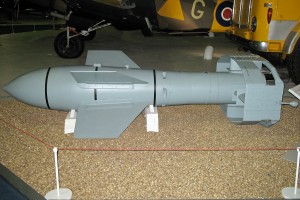
Anti-Ship Bombing in World War II
Bombing in 1943 was a notoriously inaccurate practice. Hitting a capital ship on the move was difficult, even when hundreds of bombers massed for an attack, dropping ten or more bombs each. Multiple attempts to sink the German battleship Tirpitz had failed in just such a manner. The widespread area hit by bombers was demonstrated just the day before when a fleet of 131 B-17 Flying Fortress bombers had flown against the town of Frascati, Italy. The American air raid had intended to target the headquarters of Nazi Field Marshal Albert Kesselring. They missed killing Kesselring, but 485 Italian civilians were killed in the explosive swath the fanned out across the town. That very same day, on September 8, 1943, Mussolini’s Fascist Government had surrendered. With that act, the Italian military switched sides to fight alongside the Allies against the Nazis. The lives of the townspeople lost were pointless.
Both sides had planned for the inevitable surrender of Italy as the Allies worked their way up the nation’s famous “boot”. While Italy’s army was stripped of capabilities and manpower and its air force was decimated, the Italian Navy alone still retained serious power. For the Allies, the armistice with Italy meant that the Italian Navy could be brought onto the Allied side. Of particular interest were the two battleships, Roma and Italia — sister ships with extraordinary capabilities.
The major core of the Italian fleet was at anchor at La Spezia. Even if it was within reach of German air power, there was confidence that the Germans would not be able to strike quickly or effectively to remove the threat. With the surrender of Italy, the Americans demanded that the Italian ships immediately sail for the safety of North Africa. The Italians compromised and instead agreed to proceed to Malta, and they set sail the following day on September 9, 1943.
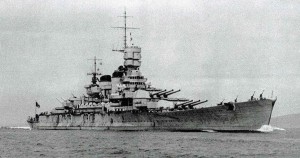
For the Germans, the Italian battleships were a significant concern. The Nazis realized that they had to catch the ships and sink them before they could be turned against Germany in the war at sea. From Germany’s perspective, in 1943 the war was far from lost — D-Day and the landings at Normandy were still nine months ahead (though obviously the German high command did not know that, even if they were planning for an invasion at some point). The battle was raging on multiple fronts and the Allies were not yet in control of the skies over Germany. U-Boats were still terrorizing the Atlantic, though the advent of airborne radar and new sonar systems were turning the tide. The air war over France and Germany was hard fought and far from decided.
A Revolutionary Smart Bomb — the Fritz X
While Allied air power was predicated on the concept of swarms of bombers, hundreds in number, dropping eight to ten bombs each, flying together in a long bomber stream over target areas, the Luftwaffe could not hope to field such large numbers. Instead, Germany had to develop a different approach. They chose to develop a precision-guided glide bomb that was launched from a bomber and guided into its target by radio-control. The German innovation was the world’s first truly successful smart bomb — the FX 1400, know commonly among both German and Allied personnel as the Fritz X.
The Fritz X was developed by Dr. Max Kramer of the Ruhrstahl AG steel and armaments corporation. It was an extraordinarily large bomb, weighing in at 3,000 pounds and carrying a warhead of 700 pounds of amatol explosive compound. It had a radio guidance receiver — FuG 203/230 Kehl-Strassburg very short-wave radio system — and fins for maneuvering and flight. The bomb had dual axis control, allowing the radio operator on board the launch aircraft to transmit signals that controlled the angle of descent as well as turned the bomb to the left and right. The Fritz X had no rocket propulsion system nor other type of thrust — put simply, once dropped, it glided in at a moderately steep angle toward its target and the controller, looking down and slightly backward from the launch aircraft, would visually guide it into the target.
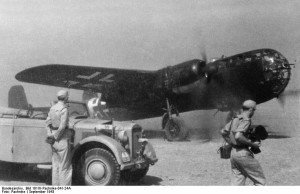
To ensure maximum effectiveness, the Luftwaffe organized a dedicated smart bomb Gruppe under the command of Hauptmann Bernhard Jope. The unit was designated III. Gruppe of Kampfgeschwader 100 Wiking (III/KG100) and was deployed to Istres near Marseilles, France. The unit was equipped with a specially modified variant of the Do 217 “Flying Pencil”, designated the Do 217K-2. Up-engined and equipped with a radio guidance transmitter system, the bombers were purpose-built for the Fritz X mission.
It was hoped that even a single targeted hit would prove devastating, as the Fritz X was aerodynamically designed and strengthened for deep penetration against heavily armored Naval capital ships. Control was precise enough in the hands of a trained technician that the bombs could be aimed not just to hit a ship but even to select where on the ship to hit. This could maximize the damage done to key points, such as the propulsion systems, the bridge or the areas of the ship containing the magazines, traditionally directly beneath the large gun turrets.
The Attack
On September 9, 1943 — today in aviation history — the Luftwaffe launched its first successful smart bomb attack. The Fritz X made its deadly debut against the Italian fleet, which in accordance with Allied orders upon the surrender of Italy, had weighed anchor and was steaming out of the port at La Spezia toward Malta when the German air raid arrived over the target.
The attack was to be Germany’s only chance to catch the Italian ships before they were out of range and somewhere across the vast waters of the Mediterranean Sea. A reconnaissance plane was shadowing the Italian fleet and reporting on their progress — the distance was over 200 miles. The flight was a long mission — 1 hour and 45 minutes each way — but well within range of the German bombers.
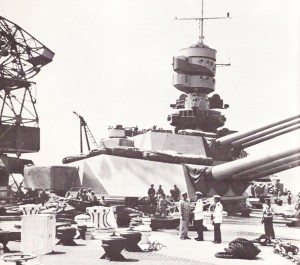
Six Do 217K-2s of III/KG100 under Hauptmann Bernhard Jope’s personal command took off into the afternoon skies at around 2:00 pm from their base at Istres, near Marseilles. Each aircraft carried a single Fritz X smart bomb. Jope planned a single pass to maximize tactical surprise. He viewed that a small group of six bombers would likely achieve the desired results with minimum exposure to casualties. A single pass overhead would be all that they flew — a second pass over the target would likely be met with a hail of AAA fire. It seemed clear that the Italian fleet would not feel overly threatened by so few bombers.
The German bombers arrived over the target without having been intercepted. At first, the six aircraft of III/KG100 shadowed the fleet so as to plan their attack carefully. They had maintained radio silence until that point in the mission. Observing the ships below, they broke radio silence to assign a target to each of the planes.
Down below, the Italians, who had been promised air cover by the Allies, wondered if the distant orbiting aircraft were Allied or German. Was this their promised air cover? Then, the planes lined up and began an attack run. Coming in a loosely organized gaggle and almost singly, the planes lined up into what looked like an undisciplined, uncoordinated attack. One by one, each made a run and released a single bomb from high altitude.
The pilots bomb controllers on board the Do 217K-2s had trained extensively for this mission, however. The loose formation didn’t matter since they were not attempting to group their bombs over a target area. More critically, they had to fly in a way that allowed them to be free to line up as they chose and to ensure that at the drop point, each plane’s Fritz X was already on a good angle toward the target. The Italian ships threw up heavy anti-aircraft fire. This did nothing to break the concentration of the radio control operators, however, as the shells exploded off their altitude, too low to be a threat.
Their two primary targets were the largest in the fleet, the battleships Roma and Italia. Three of the Fritz X bombs were guided toward each. Once dropped, according to one autobiography, the bombs took around 41 to 42 seconds to strike the ships. The battleship Italia suffered a direct hit and two misses. Even that one hit caused extensive damage that would require significant repair before the ship could rejoin the war effort. It was the Roma, however, that would sadly serve as a demonstration of the potential of this new generation of smart bombs.
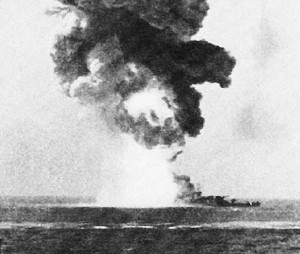
The Death of the Roma
When the first Fritz X bomb hit the Roma, it came in from the starboard side. It easily punctured the armor plating, drove through six decks and exited the bottom of the ship before exploding directly underneath the keel. It was a devastating strike — the time was 3:45 pm.
Instantly, two boiler rooms and the aft engine room were flooded. Two of the ship’s four screws were instantly taken out of action. Electrical fires sparked and began to spread throughout the stern. Then, five minutes later at 3:50 pm, another of these new miracle bombs came down. To observers, it seemed as if the bomb turned slightly and flew into the ship’s bows at a steep angle. How could this be?
Like the other, it too penetrated the armor, drove deep into the hull before detonating in the forward engine room. The bottom of the ship was holed in two places. Massive amounts of water flooded in. Just above the explosion point, the magazine for the #2 main turret gun caught fire. Instants later, the fires ignited the large stores of gunpowder, which exploded with such force that the #2 turret flew vertically off the ship into the sea. A massive mushroom cloud over 3,000 feet high erupted over the ship. Amidst the firey explosion, another of the German guided bombs flew in. It barely missed and exploded alongside in the water, sending severe shock waves through the ship.
Out of three bombs dropped against the Roma, two had hit, causing devastating damage. The ship began to sink, tipping to the starboard side as the bow slipped forward into the waves. Many of the crew were burned alive at their stations. After twenty minutes amidst a blazing inferno, at 4:12 pm, with a suddenness that was shocking, the ship flipped over and broke in two.
The fleet’s commander, Admiral Carlo Bergamini, the captain of the Roma, Adone Del Cima, and 1,253 men perished (including 86 officers). The ship sank so swiftly that even those still uninjured could not escape in time. Amidst the chaos, 596 men managed somehow to survive. They were picked up in the water by the other ships in the Italian fleet.
The attack was a stunning blow. What shocked the Italians moste was that the attack had been carried out not by fleets of hundreds of bombers, but by just six aircraft, using some sort of miracle bomb. At once, the Italians realized that they had face some new use of radios that had controlled the bombs. Not only had the bombs been clearly steered into the ships, instead of exploding harmlessly against the armor plate, they had penetrated through the thick steel with apparent ease to explode within the bowels of the ship or under its keel.
With the air raid completed, the six German bombers turned and headed back to their base at Marseilles, France. They landed without incident and celebrated the first successful smart bomb attack in history.
The Fritz X had made its mark. This was just the beginning. Hauptmann Jope’s aircraft, with Ofw. Kurt Steinborn guiding the bomb, had scored the fatal hit, while the first bomb that had hit the stern was dropped by Leutnant Klaus Deumling’s aircraft — it was his first combat sortie.
Lt. Deumling would later write, “…as we made our way home we realised that we had achieved a good hit and had come away without a scratch. At the time we had no thoughts for the victims — that is why sixty years later I find the pictures taken that day so disturbing… that myself and my crew had not launched the second and fatal bomb to hit the ship was of little consolation….”
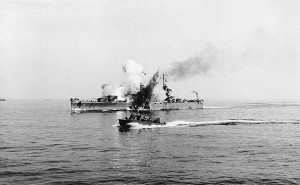
A Series of Unprecedented Successes
The attacks against the two Italian battleships would prove to be the greatest success achieved by III/KG100 and its Fritz X smart bombs, even if far more damage was yet to be inflicted. After the attack on September 9, 1943, the 11 serviceable aircraft III/KG100 continued to wrack havoc on Allied shipping off of Italy for another week of intensive combat operations.
On September 11, 1943, the group scored a hit against the US Navy’s light cruiser USS Savannah as it supported the invasion of Salerno. Again, the bomb struck the magazine and caused a massive explosion. Though badly damaged, USS Savannah made it back to port for repairs. It survived despite missing much of its bow section. A near miss on the Savannah’s sister ship, USS Philadelphia, also caused some damage, but it was easily addressed while underway.
Two days later, the British light cruiser, HMS Uganda, was hit badly in another strike. The Fritz X rammed through the steel armor plating and penetrated seven decks before exiting beneath the ship to explode directly under the ship’s keel. HMS Uganda too somehow avoided sinking and was towed back to port for extensive repair work.
The smart bomb assault continued the following day when two merchant ships were hit.
Then, on September 16, again off Salerno, III/KG100 launched yet another Fritz X attack. This time they targeted the British battleship, HMS Warspite. One bomb hit and it pierced the heavy armor plating, penetrated through six decks and exploded in the number 4 boiler room, blowing out the ship’s double bottom. A second near-miss holed HMS Warspite at the waterline. She too somehow avoided sinking and was towed to port for heavy repairs.
The following day, III/KG100 came back against the USS Philadelphia, though it achieved two near-misses. Also that day, III/KG100 would achieve hits that damaged the Dutch sloop Flores and the destroyer Loyal. This would prove to be III/KG100’s last mission before being withdrawn from the battle. A veritable fleet of ships had been seriously damaged or sunk by a small gruppe of just a dozen aircraft.

The End of III/KG100
Redeployed north into France in Spring 1944, III/KG100 was tasked to defend against the coming Allied invasion from across the Channel. Thrown into combat against the massive invasion fleet, the group would find its luck had turned. First, the Do 217K-2s were no match for the massive AAA barrage thrown up by the invasion fleet. As well, the skies that were dominated by Allied air power. Eight of their 13 serviceable Do 217K-2s were shot down in just ten days.
Further, the Germans were surprised to find that the Allies had deployed new radio jammers which reduced their control and the accuracy of the Fritz X bombs. It appeared that the Allied forces had learned the lesson off of Salerno and had developed countermeasures for this new bomb.
Decimated, III/KG100 would withdraw, only to be called back into action in July when the Allies were threatening to take and cross the bridges over the Rivers Sée and Sélune. The last dozen planes were launched in a last ditch effort to take down the bridges. Seven were lost, though one hit on a bridge was scored. The stunned remnants of the group were then disbanded and integrated into other units within the Luftwaffe.
The actions of III/KG100 and its Fritz X smart bombs rank among the most successful operations undertaken in the entire war. One small unit able to keep just a dozen serviceable aircraft at any one time had sunk a battleship, damaged two others seriously, damaged two light cruisers and had hit a number of smaller warships and merchant vessels in just a few weeks of combat action. Man for man, due to the accuracy and capability of the Fritz X, it might be said that no other unit in the history of air power has ever logged as high a success rate in such a short time.
In technical terms, the Fritz X could reliably hit within five square meters when launched from 25,000 feet. At impact, its velocity was approximately 600 mph, giving it the ballistic momentum to punch through even the thickest naval armor plating. The Fritz X heralded a new era of strategic bombing, one that would culminate six decades later with the “Shock and Awe” campaign against Baghdad during the Second Gulf War.
One More Bit of Aviation History
For decades, like most other leading air forces in the world, the Israeli Air Force (IAF) has employed smart bombs, often taking US designs and advancing on them with homegrown technologies. Yet the cost of such weapons is often not warranted by the types of targets. With skilled pilots and extensive experience and training — of which there was no shortage in Israel — the IAF realized that nearly equivalent accuracy could be attained with ballistic “dumb” bombs. The IAF would later comment at a Pentagon meeting that what was important was to use fewer smart bombs and more smarter pilots.
Today’s targeted munitions rely on a range of systems, including GPS guidance, laser-designated targets (where the target is illuminated with an invisible IR laser either by a ground team or from the air), TV-camera interfaces where the bomb is aimed through a camera picture transmitted from its nose, and other systems that remain classified. All of these weapons owe a debt to Dr. Max Kramer and his pioneering work on the Fritz X, the world’s first successful precision-guided bomb.
Today’s Aviation Trivia Question
What became of Dr. Max Kramer and Hauptmann Bernhard Jope after the end of World War II?

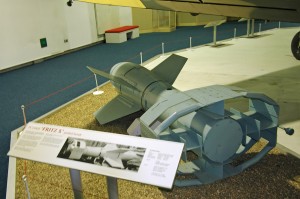
The IAF should have saved their breath. The Pentagon hasn’t learned a thing since it used dozens of $20,000 dumb bombs attempting to destroy $100 VC bridges in Viet Nam.